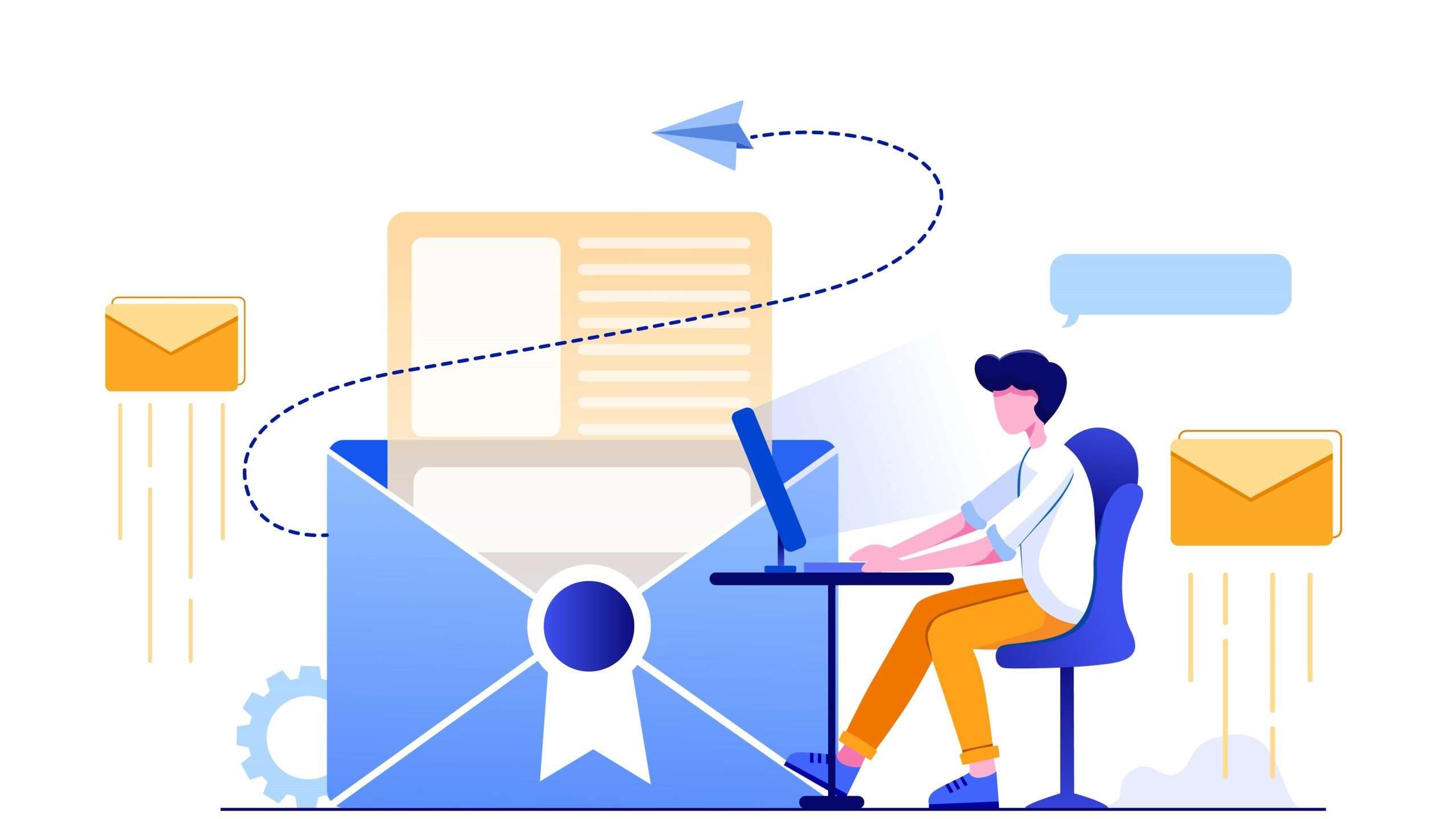Businesses have started trusting mobile apps to expand their customer base and boost their conversions. For there is an app for everything you can imagine, even small businesses are looking forward to building an app.
To make it easier for a small scale business to create a mobile app without investing a huge amount, online app creators have come up with a code-free environment to build apps easily. You don’t need to be a technical wizard for creating an app.
After having built an app for your online business, it’s time to promote it via digital marketing. While digital marketing is vast, you might want to start with the most influential part of the marketing i.e., email marketing.
In the United States, email continues to outperform other digital channels when it comes to ROI — especially in the mobile-first commerce space. According to Statista, over 90% of U.S. adults check their email daily, and mobile devices account for the majority of opens. For app marketers targeting U.S. users, crafting mobile-optimized emails is not just a best practice — it’s a necessity.
You are considered to be in the business when you have a growing list of email subscribers that allow you to keep them posted with the latest content, products, and services.
Creating email campaigns is not as easy as it appears. No matter how many subscribers you have, if they are not opening and clicking through your emails, it will all go in vain. You must optimize your email campaigns with one purpose in mind: sales. That way, optimized emails lead to optimized results and bring in revenue.
If, for example, you expected to make five sales a day consistently but only made an average of three, it’s time to change your strategy. Your email sequence is usually the first thing you need to look at when something’s not working. That’s where optimization of your email campaigns comes into play. A/B testing is a good way of improvising your emails, their variations, and the perspectives to find out what works best for your subscribers.
A/B testing is used to test variations of your email campaigns for different subset of subscribers to figure out which variation delivers the best results.
Depending on your business goals, this testing can vary in complexity. For example, you can tweak the subject lines of your emails while sending the same content to different groups of email subscribers. You can even simplify the content in order to get maximum feedback.
In this post, we will discuss the basics of A/B testing to optimize email campaigns.
Moreover, we have laid down a few tips on how you can improve your email campaigns. That way, you will be able to establish your own email A/B testing campaigns in a matter of a few hours.
1. Identify the problem & establish goals
Identify the bugs that are dropping your conversions or are simply clogging your email campaigns. To find these bugs, you will have to look at two critical metrics:
a. Open Rates
This metric statistically shows you how many subscribers from your list are opening your emails.
b. Click-Through Rates (CTR)
This is the metric that represents the ratio of subscribers who click links provided in the emails they are reading. Follow this formula to calculate your CTR:
CTR = Clicks/Impression
For example, if the clicks are 5 and the impression is 1000, it means that your CTR is (5/1000 * 100) 0.5%.
These metrics influence the overall performance of conversions.
If, however, most people are opening your emails, but only a few are actually clicking through your links, you will surely need to improvise them to increase your CTR rates. Therefore, it is important you realize your A/B testing goals before you start looking at these metrics.
2. Establish what you will tweak
Now you know that what your aim is, start analyzing your email campaign and your subscriber’s list.
The cause and effect principle also applies here. Even a small change in the pattern of your emails will influence the long-term result.
Here’s what you should pay attention to:
a. The subject line
For example: Instead of using ‘Improve Productivity in 90 Days’, use ‘The Ultimate 90 Days Productivity Guide’.
b. The headlines of your emails
For example: Look at the difference –
‘Grab this amazing 90% discount today’ vs. ‘90% Discount on the best products’
c. The Call-to-Action (CTA)
For example: Consider using ‘See Features & Pricings’, instead of ‘Grab a copy now for only 9$’
d. The structure and the layout of your emails
For example: Use two columns rather than a single column
e. Testimonials you should add
For example: Add the best user testimonials instead of all testimonials
f. The way you address the person
For example: Use ‘Jane’, instead of using ‘Ms. Jane
g. The way you close the email
See how: ‘Reply this email and let us know what you think’ or ‘Check out more tips on our page.’
h. The body style personalization
Use Calibri, 11 font size rather than using Times New Roman
i. Your specific offers
Write ‘Earn a 30% discount’, rather than ‘Win free shipping.’
j. The images you use
For example, using ‘Images with the product only’, instead of using ‘Images with humans that show emotions’
Each element influences your conversion metrics.
For example, your email headlines influence whether the reader keeps reading your offer or not. The call-to-action metric directly affects your conversion rate because people won’t be tempted to take action and purchase something without sufficient encouragement.
Before you launch an email, conduct A/B testing for that email and its sequence. Decide the number of components you are going to test first, and how you will end your campaign.
3. Test every subscriber or just some

Test the entire subscribers’ list to get the most accurate impression of how your audience performs to your new email campaign. This way, you can get in touch with all your subscribers. However, there are a few situations in which you should not test your entire subscribers’ list, only just parts of it:
Let’s say: if you are offering a discount or limited time offer, giving reward points to everyone would no longer make sense. Decide the number of subscribers who will receive these reward points, and then start sending different emails to different segments of your subscribers’ list.
Segment your subscribers’ list with a similar interest, but not more than that. Once you get the insights, design your best version of the email campaign, and only then begin scaling it. If, for example, your list is huge, it is ideal to test the most significant sample. Ensure every subscriber is random to improve the accuracy of the results.
4. Analyzing the results
While there are more factors to keep in mind while preparing a perfect email marketing campaign, it’s important that you begin with testing first.
Most people argue that you cannot analyze the conversion rate simply by testing emails. However, this is not true. The conversion rate could severely be influenced by your website design, UX, marketing strategies, though. Your email campaigns are probably the most important part of the conversion process. Therefore, you can neglect the conversion rate while analyzing your A/B testing results. Else, it would be a serious mistake.
Once you get the results from your split testing campaigns, start tracking the conversion rates. You might have noticed that some campaigns lead to a better CTR but have lesser conversions.
On the whole, the end goal is to make sales, not to get clicks. You can use a few A/B split testing tools that will help you with the analytics process.
Important tips on how to make A/B testing better
1. Split your subscribers into groups
Split your subscriber’s list into random groups of people in order to receive more precise feedback. If, however, you are using an A/B testing email service, you should be able to do this with the help of an app. If you don’t, you will need to manually segment your list into such groups, which are also called samples.
2. A/B testing works best for frequently sent emails
A/B testing is not recommended on the rare emails like holiday promotion emails. Just imagine you will only be able to use the results in twelve months. Therefore, you will need to focus on frequent emails, which are recommended by most professionals.
Usually, frequent emails are like newsletters; new articles posted on blogs, alerts, and sales pitches. Such emails are generally sent through an automatic email sequence and keep rolling until you stop it.
If, however, you make a small change in only one frequently sent an email, you might improve your chance of converting every new subscriber to a loyal one.
3. Think out of the box
You need to think above average if you want to accomplish something above average. Therefore, whenever you are creating new variants for testing your list, you will need to step up to come up with something unique.
Consumers, in recent times, are already dissatisfied of seeing the same things over and over again. You need to introduce something original that will capture more users’ attention, and hence improve your email campaign’s performance.
The more significant the difference between your emails, the smaller your sample dimension can be.
4. Establish the ‘statistically significant’ value
Never rush with your final decision with the result of the A/B testing process. Remember that there are more factors when you decide which sample performed best in terms of actual profitability.
There are numerous A/B significance testing calculators that can be used for free, so you should give them a shot.
Statistical significance cannot be measured after just one A/B testing effort. You need consistent results that repeat themselves at least a few times before deciding the best campaign version.
5. Take action while learning from mistakes
Once you find a statistically significant result and if it also matches your previous results and suppositions, this means you might be onto something. Ensure you get the result you wanted. If not, then start making the change.
Now that you have an optimized email performance based on statistics rather than suppositions, you might come across many challenges during your journey. You can also commit many mistakes. The secret to A/B testing is to learn from your mistakes and not repeat them again. Regular practice leads to perfection. This is what you are aiming for when you are looking to improve your email marketing performance.
6. Use email marketing automation tools
Many automation digital tools are incorporating the entire email auto-responder option. You can opt for the tool that you believe works the best for your email campaigns. Use that tool to ease the entire A/B testing process and automate your time-consuming tasks.
For example, CEOs and entrepreneurs deal with their successful businesses by delegating and outsourcing everything they find difficult to perform on their own. This gives them time and energy to focus on the important aspects of their business.

Takeaways
Building an app with a mobile app builder for WordPress is easy with a few clicks. Moreover, to promote it, A/B testing is definitely the best way to create a cycle that will gradually improve your marketing and sales performance.
Creating email campaigns are always complex. However, if you are willing to spend some time analyzing and then changing your sales funnel, you will likely improve your open rates, click-through rates, and eventually conversion rates.
A/B testing campaign is not as simple as it appears if you want to perform a successful email. You might get overwhelmed by the number of details and insights you receive from this post.
If you are determined, nothing is going to stop you from optimizing the sales funnel you will build or come across in the future.
